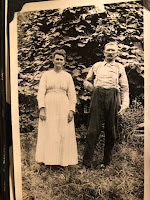 I have an
interest in peoples’ names – how they got them and what they might tell us
about the person’s background.
I have an
interest in peoples’ names – how they got them and what they might tell us
about the person’s background.
For
instance, my dad was named after his father, Paul Manuel Douglass. I remember
asking him where the name Manuel came from – it looks Hispanic, although I’m
unaware of any such lineage. (It’s pronounced
“Man-u-el,” rather than “Man-wel.”). He didn’t know and had never inquired. Maybe
my dad didn’t share my curiosity.
There’s a
motherlode of interesting names on my mom’s side of the family. My maternal
grandmother’s family, the Harpers, were farmers in central West Virginia. John
David Harper, who I appear with in an old black and white photo as an infant,
had a wooden leg; I believe he lost it in a railroad accident. I don’t know
anything about his wife, Lucinda Jane Evans, other than she bore 10 children
whose names, and those of their spouses, are listed below:
|
Child
|
Married
|
|
Florence
Emma
|
Steve
Stevens
|
|
Grace
Olive
|
Wilbert
Kerens; upon his death,
Enos
Kerens (Wilbert’s brother)
|
|
Effie
Ellen
|
Clyde
Kerens (Wilbert’s and Enos’ brother)
|
|
Charles
Jennings
|
Roella
|
|
Lella
Fern
|
Hoke
Caplinger
|
|
Oscar
Maxie (died in infancy)
|
|
|
Orpha
Mona
|
Joe
Taylor
|
|
Blanche
Leona (my grandmother)
|
Earl
Frank Egleson
|
|
Floyd
Michael
|
Edna;
upon her death,
Pearl
|
|
Opal
Vergie
|
Hubert
Martz
|
 I remember
many of these folks and relished saying the couples’ names: Grace and Enos,
Lella and Hoke, Opal and Hubert, and Orpha (pronounced “Orphie”) and Joe. Why
would John and Lucinda name a daughter Grace Olive? Or Orpha Mona? Or Effie
Ellen or Opal Vergie? I’ll never know. Perhaps they weren’t unusual-sounding
back at the turn of the 20th Century in Appalachia.
I remember
many of these folks and relished saying the couples’ names: Grace and Enos,
Lella and Hoke, Opal and Hubert, and Orpha (pronounced “Orphie”) and Joe. Why
would John and Lucinda name a daughter Grace Olive? Or Orpha Mona? Or Effie
Ellen or Opal Vergie? I’ll never know. Perhaps they weren’t unusual-sounding
back at the turn of the 20th Century in Appalachia.
The
Harpers were farm people who took pride in subsisting on what they grew or made.
Like Blanche and her family, my grandfather, Grandpa Earl, grew up on a farm in
West Virginia. He wrote a memoir explaining how he helped make everything from
maple sugar to wool socks. His family’s farm had a coal mine, pigs, sheep,
vegetables, hay, and fruit trees.
When I was
a kid, we would make the six-hour drive from Rockville, Maryland, up and around
the Appalachian Mountains, to a state park in Elkins, West Virginia for the
annual Harper family reunion. Inside a covered shelter were rows of picnic
tables groaning under the weight of hams, chicken, homemade salads, rolls, side
dishes of every variety, and pies. I mean, pies. Peach pies, apple pies, banana
cream pies, chocolate pies, coconut cream pies, rhubarb pies. Lots of pies.
Some of
these families moved to Florida in the 1960s. I remember going to a fish fry at
a park by the St. John’s River near Deland. One lasting memory is of the segregated
bathrooms and water fountains, marked “Colored” and “Whites.”
Such signs
were only at the surface of deep, institutional, court-supported
discrimination. As recently as my childhood, Jim Crow laws were alive and well,
and not just in the deep South. Blacks were openly and widely treated, if as
citizens at all, as third-class citizens, disadvantaged in every aspect of
society: schools, job prospects, housing, voting. The movie Green Book focused on the issue, but I
think glossed over it a bit. While Jim Crow laws have been rescinded, prejudice
remains alive and well – in subtle and unspoken undercurrents and, in the last
two years, ways that are not so quiet nor indirect.
I’d like
to think my kin were staunchly opposed to such indefensible bigotry. But that’s something else I’ll never know.




Hello,
ReplyDeleteI am starting to create my own genealogy blog. I hope you don’t mind me using your blog posts for inspiration? Your family history and photos are very intriguing. I would love to have such a diverse genealogy like your own.
All the best,
Kian.